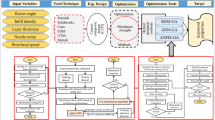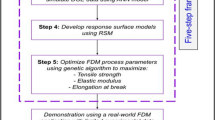Abstract
Fused deposition modeling (FDM) is an additive manufacturing technique used to fabricate intricate parts in 3D, within the shortest possible time without using tools, dies, fixtures, or human intervention. This article empirically reports the effects of the process parameters, i.e., the layer thickness, raster angle, raster width, air gap, part orientation, and their interactions on the accuracy of the length, width, and thickness, of acrylonitrile-butadiene-styrene (ABSP 400) parts fabricated using the FDM technique. It was found that contraction prevailed along the direction of the length and width, whereas the thickness increased from the desired value of the fabricated part. Optimum parameter settings to minimize the responses, such as the change in length, width, and thickness of the test specimen, have been determined using Taguchi’s parameter design. Because Taguchi’s philosophy fails to obtain uniform optimal factor settings for each response, in this study, a fuzzy inference system combined with the Taguchi philosophy has been adopted to generate a single response from three responses, to reach the specific target values with the overall optimum factor level settings. Further, Taguchi and artificial neural network predictive models are also presented in this study for an accuracy evaluation within the dimensions of the FDM fabricated parts, subjected to various operating conditions. The predicted values obtained from both models are in good agreement with the values from the experiment data, with mean absolute percentage errors of 3.16 and 0.15, respectively. Finally, the confirmatory test results showed an improvement in the multi-response performance index of 0.454 when using the optimal FDM parameters over the initial values.










Similar content being viewed by others
References
Sood AK, Ohdar RK, Mahapatra SS (2009) Improving dimensional accuracy of fused deposition modeling processed part using grey Taguchi method. Mater Des 30(10):4243–4252
Elsayed EA, Chen A (1993) Optimal levels of process parameters for products with multiple characteristics. Int J Prod Res 31(5):1117–1132
Hopkinson N, Hagur RJM, Dickens PH (2005) Rapid manufacturing: an industrial revolution for the digital age. Wiley, England
Pilipovic A, Raos P, Sercer M (2009) Experimental analysis of properties of materials for rapid prototyping. Int J Adv Manuf Technol 40:105–115
Ghazanfari A, Li W, Leu MC (2015) Adaptive rastering algorithm for freeform extrusion fabrication processes. Virtual Phys Prototyp 10(3):163–172
Ali F, Chowdhury BV, Maharaj J (2014) Influence of some process parameters on built time, material consumption, and surface roughness of FDM processed parts: influences based on the Taguchi design of experiments. In: Proceedings of 4th IAJC/ISAM joint international conference on engineering and related technologies, vol 1. Orlando, Florida, USA, pp 1–18
Chockalingama K, Jawahara N, Chandrasekar U et al (2008) Establishment of process model for part strength in stereo lithography. J Mater Process Technol 208:348–365
Taufik M, Jain PK (2016) A study of build edge profile for prediction of surface roughness in fused deposition modeling. J Manuf Sci Eng 138(6):061002–0610013
Bochmann L, Bayley C, Helu M et al (2015) Understanding error generation in fused deposition modeling. Surf Topogr Metrol Prop 3(1):014002–014007
Rayegani F, Onwubolu GC (2014) Fused deposition modelling (FDM) process parameter prediction and optimization using group method for data handling (GMDH) and differential evolution (DE). Int J Adv Manuf Technol 73(1):509–519
Vaezi M, Yang S (2015) Extrusion-based additive manufacturing of PEEK for biomedical applications. Virtual Phys Prototyp 10(3):123–135
Francis V, Jain PK (2016) Experimental investigations on fused deposition modelling of polymer-layered silicate nanocomposite. Virtual Phys Prototyp 11(2):109–121
Es Said OS, Foyos J, Noorani R et al (2000) Effect of layer orientation on mechanical properties of rapid prototyped samples. Mater Manuf Process 15(1):107–122
Lee JY, Tan WS, An J et al (2016) The potential to enhance membrane module design with 3D printing technology. J Membr Sci 499:480–490
Srivastava M, Maheshwari S, Kundra TK (2015) Experimental evaluation of FDM process for production cost optimization. Int J Res Mech Eng Technol 5(Suppl 1):63–72
Khan ZA, Lee BH, Abdullah J (2005) Optimization of rapid prototyping parameters for production of flexible ABS object. J Mater Process Technol 169:54–61
Anitha R, Arunachalam S, Radhakrishnan P (2001) Critical parameters influencing the quality of prototypes in fused deposition modeling. J Mater Process Technol 118:385–388
Chou K, Zhang Y (2008) A parametric study of part distortion in fused deposition modeling using three dimensional element analysis. Proc Inst Mech Eng B J Eng Manuf 222:959–968
Venkata RN, Pandey PM, Dhande SG (2007) Part deposition orientation studies in layered manufacturing. J Mater Process Technol 185:125–131
Bellehumeur CT, Gu P, Sun Q et al (2008) Effect of processing conditions on the bonding quality of FDM polymer filaments. Rapid Prototyp J 14(2):72–80
Stuart PG (1993) Taguchi methods: a hand on approach. Addison Wesley, New York
Liao YS, Chiu YY (2001) A new slicing procedure for rapid prototyping systems. Int J Adv Manuf Technol 18:579–585
Zimmerman HJ (1991) Fuzzy set theory and its applications. Kluwer, London
Boschetto A, Giordano V, Veniali F (2013) 3D roughness profile model in fused deposition modeling. Rapid Prototyp J 19(4):240–252
Author information
Authors and Affiliations
Corresponding author
Rights and permissions
About this article
Cite this article
Padhi, S.K., Sahu, R.K., Mahapatra, S.S. et al. Optimization of fused deposition modeling process parameters using a fuzzy inference system coupled with Taguchi philosophy. Adv. Manuf. 5, 231–242 (2017). https://doi.org/10.1007/s40436-017-0187-4
Received:
Accepted:
Published:
Issue Date:
DOI: https://doi.org/10.1007/s40436-017-0187-4




